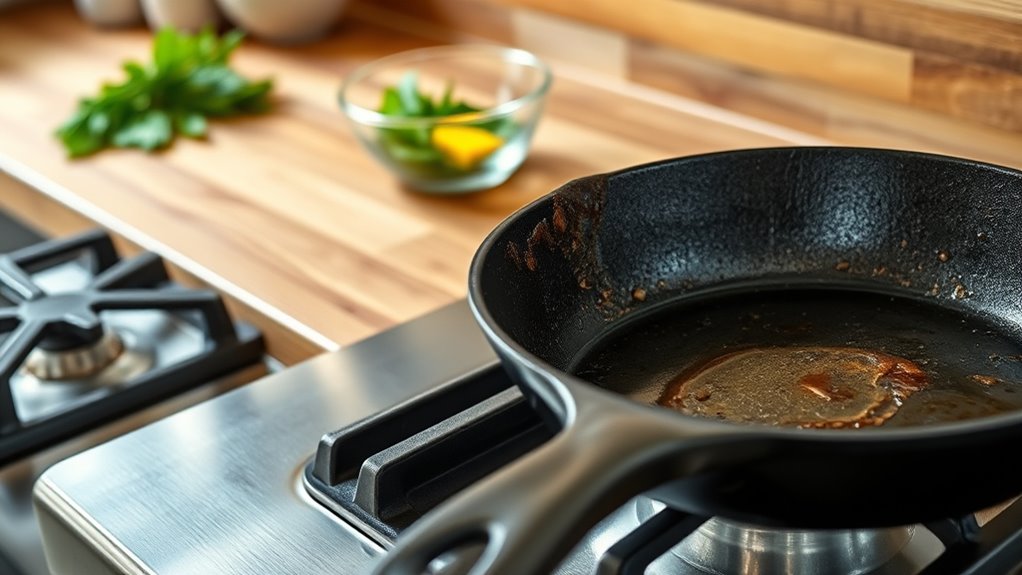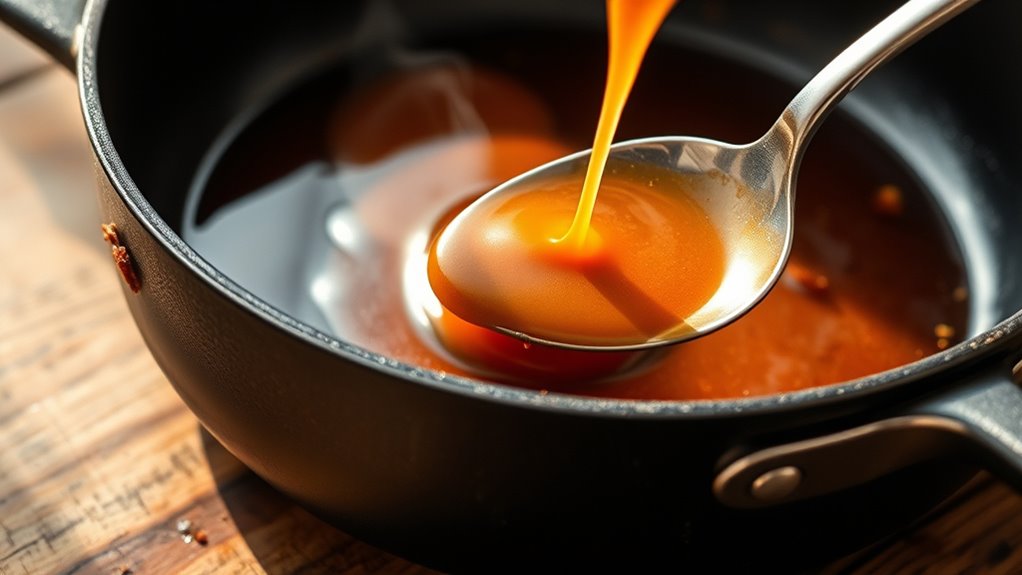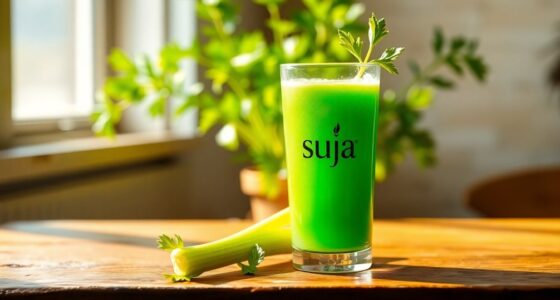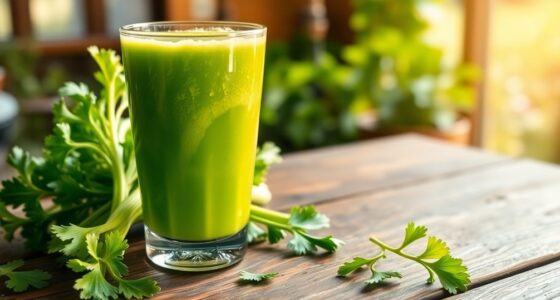Before jumping back into pan sauce basics, focus on perfecting your seasoning and ingredient substitutions, ensuring meat or vegetables are properly seasoned beforehand. Master deglazing by loosening browned bits with wine, broth, or water right after searing, to build flavor. Always taste and adjust seasonings as you go, balancing acidity, salt, and sweetness. Getting these foundational steps right will set your sauces up for success—continue on to discover how to create truly vibrant, well-rounded flavors.
Key Takeaways
- Properly season your ingredients before adding liquids to build a flavorful base.
- Deglaze the pan immediately after searing to extract maximum browned flavor.
- Taste and adjust seasoning throughout cooking to maintain balanced flavor profiles.
- Use the right amount of liquid—enough to loosen bits without diluting the sauce.
- Incorporate acidity and sweetness thoughtfully to enhance and round out the sauce’s flavor.
Essential Steps Before Perfecting Your Pan Sauces

Before you dive back into making pan sauces, take a moment to master a few foundational steps that can make all the difference. The key to a great pan sauce isn’t just about following a recipe; it’s about understanding how to enhance flavors through proper seasoning techniques and how to adapt ingredients when necessary. These small adjustments can elevate your sauces from good to unforgettable. Start by focusing on seasoning techniques. When you cook meat or vegetables in a pan, be sure to season them adequately before adding liquids. Use salt to draw out moisture and enhance natural flavors, and don’t be afraid to taste as you go. A pinch of black pepper, garlic powder, or herbs can add depth early in the process. This careful seasoning creates a more flavorful base for your sauce, making it more vibrant and well-rounded.
Master seasoning techniques to create vibrant, flavorful bases for unforgettable pan sauces.
Next, consider ingredient substitutions. Sometimes, you might not have a specific ingredient on hand, or you want to cater to dietary preferences. Knowing how to substitute effectively maintains your cooking flexibility without sacrificing flavor. For example, if a recipe calls for butter and you’re out, olive oil or coconut oil can work, but be mindful of how they influence the overall taste. If fresh herbs aren’t available, dried herbs can be used—just remember they’re more concentrated, so use less. When replacing liquids like wine or broth, consider the flavor profile. Unsweetened apple cider vinegar or lemon juice can add acidity if you’re missing vinegar. A splash of soy sauce can boost umami when you lack stock. These substitutions can be made seamlessly if you understand their impact on flavor and texture. Additionally, understanding water’s role in cooking can help you better control the moisture and consistency of your sauces.
Another essential aspect is to properly deglaze the pan. After searing meat or vegetables, don’t skip this step. Use a liquid—wine, broth, or even water—to loosen browned bits on the bottom of the pan. These bits are packed with flavor and will enrich your sauce. Once deglazed, simmer gently to concentrate those flavors before adding your finishing ingredients. This step ensures your sauce isn’t just a watery topping but an intense, flavorful complement to your main dish.
Finally, always remember to balance your sauce with acidity, sweetness, salt, and fat. Taste frequently and adjust seasonings accordingly. This approach gives you control over the final flavor profile and helps you develop confidence in your sauce-making skills. Mastering seasoning techniques and ingredient substitutions doesn’t just prepare you for perfect pan sauces; it transforms your entire cooking process into one of experimentation and flavor mastery.
Frequently Asked Questions
Can I Reuse Burnt Pan Drippings for Sauce?
You shouldn’t reuse burnt pan drippings for sauce because they can ruin the flavor and introduce bitter, burnt tastes. Instead, use fresh pan drippings for flavor enhancement, ensuring your sauce tastes rich and delicious. If the drippings are just slightly burnt, you might be able to salvage them by removing the burnt bits, but generally, it’s best to start with fresh drippings for a clean, flavorful sauce.
What’s the Best Type of Pan for Pan Sauces?
You should choose a cast iron or non-stick pan for making pan sauces. Cast iron provides excellent heat retention and adds depth to your sauce, while non-stick pans make it easy to deglaze and scrape up flavorful bits. Both types guarantee your sauce develops rich flavors without sticking or burning. Using the right pan simplifies the process, giving you better control and better-tasting sauces every time.
How Do I Store Leftover Pan Sauces Safely?
To store leftover pan sauces safely, transfer them to an airtight container and refrigerate within two hours of cooking. Use storage tips like labeling the container with the date. When reheating, use gentle techniques such as simmering on low heat or microwaving in short bursts, stirring often. This preserves flavor and prevents spoilage. Consume leftovers within 3-4 days for ideal freshness and safety.
Can I Make Pan Sauces Vegan or Dairy-Free?
Think of making pan sauces vegan or dairy-free like painting a new masterpiece. You can swap traditional ingredients for vegan substitutes like coconut cream or almond milk, and use dairy-free thickeners such as arrowroot or cornstarch. These options let you create rich, flavorful sauces without dairy, so you can enjoy your favorite dishes guilt-free. With a little creativity, you’ll craft delicious, plant-based sauces that rival their traditional counterparts.
How Do I Prevent Sauce From Separating or Breaking?
To prevent your sauce from separating, use emulsification techniques like whisking in a small amount of cold liquid gradually and adding a stabilizer such as mustard or egg yolk. Make ingredient substitutions carefully, avoiding high-fat or incompatible ingredients that can cause breaking. Keep the sauce at a gentle simmer, and stir constantly to maintain smoothness. These steps help create a cohesive, beautifully emulsified sauce every time.
Conclusion
Remember, mastering the basics sets the foundation for incredible pan sauces. Did you know that chefs often spend years refining these skills? Skipping essential steps can mean losing that rich, flavorful finish you’re after. So, take your time, follow these fundamentals, and enjoy the process. With patience and practice, you’ll turn simple ingredients into culinary masterpieces. Don’t rush—your perfect sauce is just a few mindful steps away.
Susannah expertise lies in researching and compiling evidence-based content on juicing, nutrition, and overall health. She is committed to ensuring that The Juicery World offers accurate, up-to-date, and trustworthy information to empower readers to take control of their health. Susannah’s goal is to inspire individuals to embrace juicing as a way to nourish their bodies and live their best lives.











